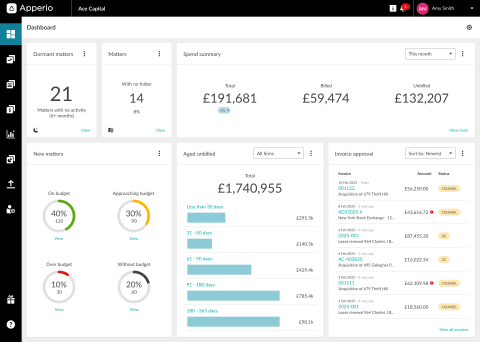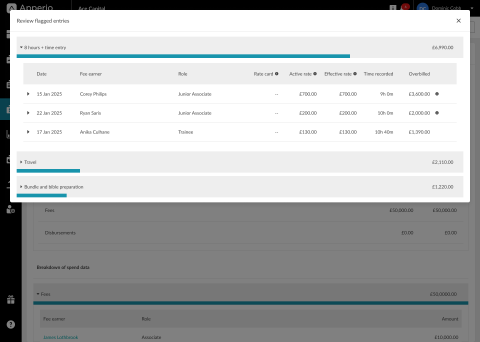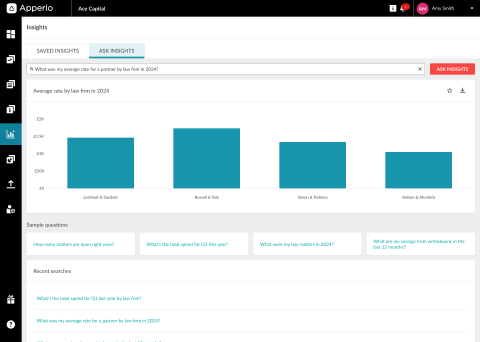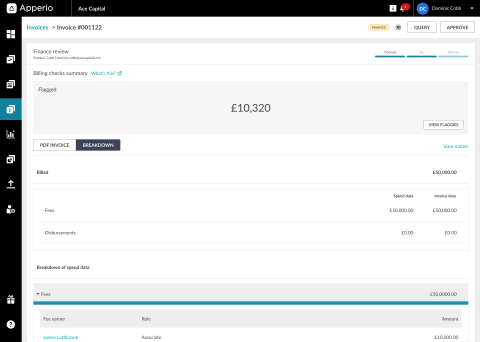Is your matter management software costing you money?

Matter management software has become a staple for in-house legal teams, providing a way to track progress, monitor scope, and keep external work on track. But while these tools are useful for organisations, they can also give a false sense of control.
It’s not uncommon to see a matter flagged as green across the board… right up until the invoice lands and blows the budget.
The issue? Most matter management platforms track operational progress — not financial performance. They’ll tell you what’s happening but not how much it’s costing. And in environments where legal work needs to be forecastable, auditable, and aligned with business expectations, that’s a serious blind spot.
This blog looks at why tracking scope and milestones alone isn’t enough and how combining matter and money oversight while work is in progress gives legal and finance teams real control over outcomes. Not just after the invoice but throughout the lifecycle of the matter.
The blind spot in matter management software
Most matter management tools are built to track progress: Are we within scope? Have key milestones been met? Are we on schedule? On paper, everything looks fine, even when the budget is quietly slipping out of view.
That’s because traditional matter tracking is operational, not financial. It’s built to show task completion, not cost impact.
And that creates a major blind spot.
Without visibility into real-time spend, it’s entirely possible for a matter to hit every milestone and still exceed budget by 20%. Scope creep, fee earner stacking, inefficient staffing, or unapproved disbursements can all drive costs up without altering the project status.
For legal and finance teams, that means the first real signal of overspend often comes too late — when the invoice lands, not when the risk first emerged.
The smarter approach is to track both matter progress and the financial story behind it. Only then can you spot risks early, manage scope more effectively, and maintain real control over outcomes.
📕Further reading: Matter management software is broken. Here’s how to fix it.
How matters go over budget while staying ‘green’
The danger with progress-only systems is they’re built for project managers, not budget holders. And that means overspend often hides in plain sight.
Here are a few real-world examples of how that plays out:
❌Fee earner stacking
A matter appears on track operationally, but the hours are being clocked by multiple high-cost senior associates instead of a properly geared team. No one flags it because nothing has technically gone wrong.
❌Late-stage scope changes
Progress tracking shows tasks completed on time. What’s not visible is the mid-matter change request that added 40% to the cost. And because that change wasn’t captured as part of budget monitoring, the team only finds out once finance asks why the accruals were wrong.
❌ Non-compliant billing behaviours
Some firms may front-load hours, double up on reviews, or batch charge time toward the end of a matter. If you’re only watching milestone completion, these behaviors don’t register, but they significantly affect cost.
In all these cases, operational updates alone would give no indication that something was off. Legal and finance teams only gain visibility after the invoice has landed… At this point, the opportunity to take action has passed.
What to monitor alongside matter progress
Progress tracking can tell you what’s happening. But to understand whether a matter is healthy, you need to track the financial signals behind the scenes and spot when they deviate from expectations.
Here are the key indicators to monitor in parallel with matter milestones:
Fee earner stacking 🧱
Track how many individuals are billing time to a matter and what levels they’re at. A high concentration of senior time (with limited delegation) can drive up costs fast, even if the matter looks simple on the surface.

Gearing ratios ⚙
Look at the mix of partners, associates, and paralegals working on a matter. Effective gearing balances senior input with cost-effective delivery. Poor gearing often means unnecessary spend without better outcomes.
Scope creep 📈
Changes in hours billed, team size, or matter duration should be compared against the original budget and scope. Repeated “minor” changes often add up and signal poor matter control.

Budget burn vs progress 🔀
Track how much of the budget has been used at each stage. If you’re only 50% through a matter but 85% through the budget, that’s a red flag — regardless of the task list status.

Accrual and invoice variance 📃
How accurate are the law firm’s accruals compared to the final invoice? Large or repeated variances suggest poor forecasting discipline and make it harder for finance to plan ahead.

These metrics are already present in your legal spend data, especially if you’re tracking WIP, billing patterns, and accruals in a platform like Apperio. The key is to bring them into view alongside operational updates, so you can see not just how a matter is progressing, but whether it is progressing in a financially sustainable way.
Matter management software: A smarter model for oversight
It’s not that matter management tools are broken. It’s that they’re only half the story.
The real value comes when progress and financial performance are monitored together — creating a live, holistic view of every matter.
Here’s what that looks like in practice:
- Continuous financial oversight sits alongside matter status updates, helping you spot misalignments as they happen — not after the invoice.
- Team structure and billing behavior are tracked continuously, so you can flag fee earner stacking or poor gearing before it compounds.
- Scope and budget drift can be caught mid-matter, enabling early conversations with firms to correct course.
- Accrual data is checked automatically against spend to ensure finance teams have accurate, up-to-date forecasts. Not estimates.
This dual-tracking model brings legal and finance teams into tighter alignment. It creates fewer surprises, strengthens panel relationships through transparency, and makes legal work feel more predictable, auditable, and commercially managed.
And crucially, it gives you the confidence that green really means green, not just that the tasks are complete, but that the cost is under control too.
Closing the visibility gap
Matter management tools help you stay organised. But without spend oversight, they can also lull teams into a false sense of security — where a project looks fine on the surface but hides inefficiencies and overspend underneath.
A successful outcome means delivering on both scope and spend. So, if you’re only reviewing financial performance after an invoice lands, you’re too late. Overspend has already happened. Relationships are already under strain. And your options for course correction are limited.
Control comes from managing scope and spend together while the work is still in progress.
That’s precisely what Apperio is built to do. It provides a live, side-by-side view of matter progress and financial performance, allowing you to flag risks early, keep budgets on track, and maintain stronger, more collaborative firm relationships.
No surprises. No chasing down numbers. Just a smarter, more commercially managed way to run legal work.
Keen to see how your matters stack up financially? We’ll show you how to pair your existing matter tracking with real-time spend insights using Apperio. Book a demo.